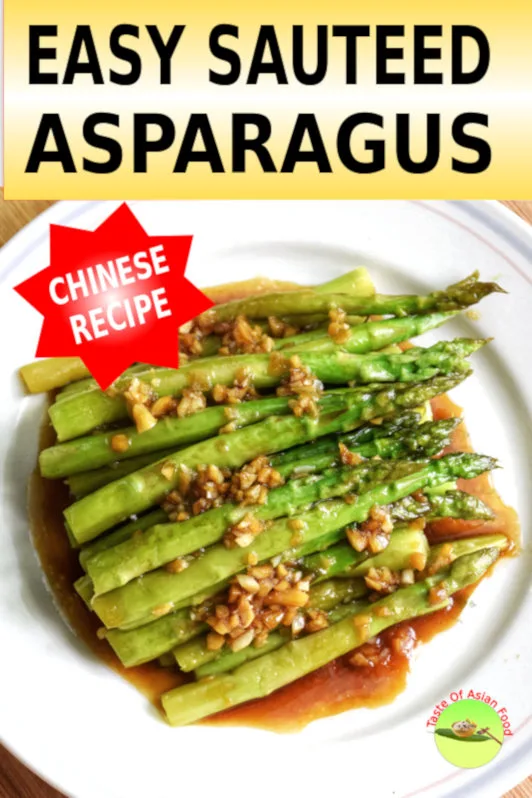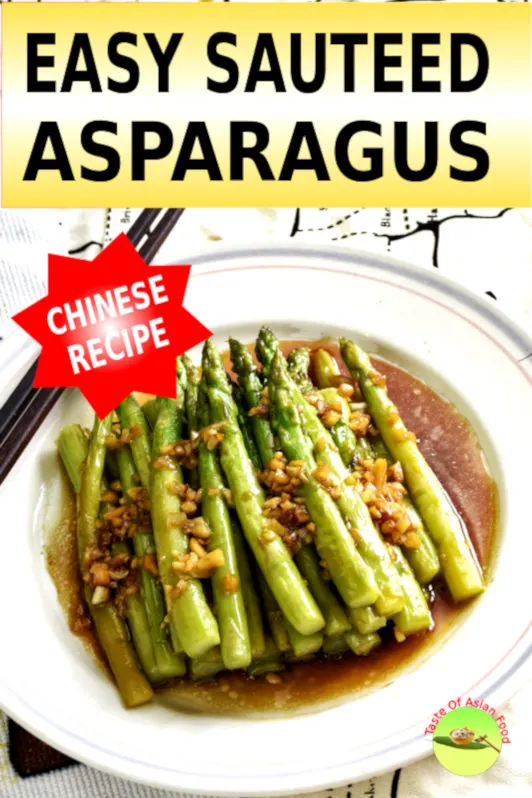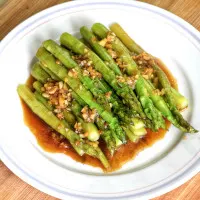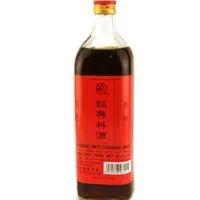Sauteed asparagus with garlic is an elegant dish served in high-end Chinese restaurants. In this article, I want to share with you the quick and easy method of how to saute asparagus with garlic in less than thirty minutes.
I will also reveal to you how to keep the color of the asparagus green and vibrant, crisp, and tender.
Let’s get started.

Note: This post may contain affiliate links. Please read my privacy policy for more info. I may receive commissions for purchases made through links in this post.
1. Prepare the asparagus
How to select asparagus
The freshness of asparagus is crucial for the success of this dish because it is lightly seasoned. Choosing fresh asparagus can be a little tricky. Here are a few tips:
- The spears should be bright green or violet tinged, firm to touch, not bend.
- The stalk should be firm, not limp.
- The tips are closed and compact. Asparagus with flowers is long past its prime, not suitable to prepare sauteed asparagus.
- If you squeeze the bunch of asparagus, it should squeak.
- The end of the stem should not be woody, dry, or crack.
Please note that the size is not the indicator of tenderness. It is just another species. Nevertheless, you will get more yield per kg for the larger asparagus.
Remove the fibrous part of the asparagus
No one wants to bite into stringy asparagus. You need to discard the tough end and the unpalatable fibrous surface.
The conventional method is to snap the asparagus into two, assume that the snapping point is where divided the tough and tender sections.
However, the snapping point is not only determined by the tenderness but also depends on where you apply the pressure. As a result, you are throwing away the edible part of the asparagus. The wastage is significant because asparagus is expensive.
A better way is to do the following:
- Cut off roughly 3cm from the bottom of each spear.
- Peel off the stringy exterior with the vegetable peeler of the bottom half until they got into the tender interior. Lay the asparagus on a flat surface make it easier and avoid breaking the spears accidentally.
Blanch the asparagus – is it necessary?
I strongly suggest adding the blanching step to this sauteed asparagus recipe. Blanching before sauteing has the benefits to reduce the time required to saute and better control of the doneness:
- Bring the water to boil in a larger pan.
- Put the asparagus in boiling water. Turn to high heat to bring the water to boil as soon as possible.
- Blanch for one minute or until the interior of the asparagus becomes semi-transparent. That’s when the asparagus is nearly cooked.
- Place it immediately in ice water to cool down the asparagus and stop cooking. The asparagus will retain its vibrant color and crunchiness.
2. Prepare the garlic sauce
This garlic sauce is typically used in many similar Chinese stir-fries and sauteed dishes.
Since I plan to prepare a vegetarian sauteed asparagus dish, there will be no oyster sauce in this recipe. You can refer to the following section about the variations of this recipe for more ideas on how to improvise the recipe by including other ingredients.
You need to crush a few cloves of garlic, coarsely chopped, and sauteed until it turns aromatic. The garlic should not be finely chopped because it can burn reasonably quick even over low heat.
You can increase the amount of garlic to obtain a more intense flavor. I like to add salt to the garlic while sautéing to make the crushed garlic a little salty. It tastes good when it clings on the asparagus with a relatively delicate flavor.

3. Saute the asparagus
Once the garlic turns aromatic, turn up the heat to roaring hot. Add the blanched asparagus.
Sauteed over high heat helps to bring out the flavor and shorten the cooking time, hence preserve the attractive bright green and crunchiness of the asparagus.
You can also stir fry it over high heat to create some wok-hei if you are using a wok over a high power stove.
After sauteeing for one minute, add the seasoning. I aim to let the flavor of the asparagus stands out, so the seasonings are relatively mild.
On the contrary, I am using ingredients with strong flavor for leafy vegetables like kangkung (water spinach). You can get the recipe of the stir fry kangkung with belacan here.
The seasoning consists of light soy sauce for flavor, dark soy sauce for color, sesame oil for aroma, along with salt, sugar, white pepper, and rice wine. Combine all the ingredients with a tablespoon of water.
Add the seasoning mixture to the asparagus. Mix thoroughly and cover the pan for one minute.
By now the asparagus should become tender but still crispy. You can take out one spear to do a taste test. Watch the asparagus closely. Remove it once it turns deep green. Do not overlook.
Prepare a cornstarch slurry by combining one teaspoon of cornstarch with a tablespoon of water. Add the cornstarch slurry to the asparagus. The sauce will thicken and cling on to the asparagus. Stop adding more cornstarch slurry once the consistency is right. You may not need to use up all the cornstarch slurry.
Transfer the asparagus to a clean chopping board. Cut the asparagus spears into half. Arrange them on a plate and drizzle the remaining sauce on top of the asparagus.
Serve.
Variations
You may consider adding chicken or shrimp to the asparagus if you are none vegetarian. In this case, substitute half of the light soy sauce in the recipe with oyster sauce to give it a different flavor.
If you prefer a vegetarian dish, add some mushrooms (any mushrooms are suitable) and carrot to give it different flavors which are also more colorful.
How to keep asparagus
Asparagus should be kept in the refrigerator. It can become stale quickly at room temperature.
- Cut off the stem.
- Wrap the stems with a damp paper towel.
- Keep the bundle of asparagus in a plastic bag /ziplock bag to retain the moisture.
Sauteed asparagus with garlic

Sauteed asparagus with garlic is an elegant dish served in high-end Chinese restaurants. In this article, I want to share with you the quick and easy method of how to sauteed asparagus with garlic in less than thirty minutes.
Ingredients
- 300g asparagus
- 4 cloves garlic
- 2 tbsp vegetable oil
The stir fry sauce (A)
- 3 tsp light soy sauce
- 1/4 tsp dark soy sauce
- 1 tsp sugar
- 1 tsp salt
- 1/4 tsp ground white pepper
- 1 tsp sesame oil
- 1 tbsp rice wine (optional)
- 1 tbsp of water
Cornstarch slurry: (B)
- 1/2 tsp cornstarch
- 1 tbsp water
Instructions
- Cut off roughly 3cm from the bottom of each spear of asparagus.
- Peel off the stringy exterior of the bottom half until they got into the tender interior.
- Blanch the asparagus in boiling water for thirty seconds or until the interior turns to semi-transparent.
- Place it immediately in ice water.
- Coarsely chopped a few cloves of garlic, and sauteed until it turns aromatic.
- Add the blanched asparagus, sauteed over high heat for a minute.
- Combine all the ingredients in (A) to make the stir fry sauce. Add to the asparagus.
- Cover the pan for one minute.
- Add a sufficient amount of the cornstarch slurry to thicken the sauce. Serve.
Recommended Products
As an Amazon Associate and member of other affiliate programs, I earn from qualifying purchases.
Nutrition Information:
Yield:
2Serving Size:
2 servingsAmount Per Serving: Calories: 207Total Fat: 16gSaturated Fat: 1gTrans Fat: 0gUnsaturated Fat: 14gCholesterol: 0mgSodium: 2929mgCarbohydrates: 12gFiber: 3gSugar: 4gProtein: 5g
This data was provided and calculated by Nutritionix on 9/12/2019





Louis
Sunday 7th of November 2021
Hi KP Kwan! I love your recipe but I can not figure out where to watch the video. If you could assist me that would be much appreciated. Thank you!
Louis
Monday 8th of November 2021
@KP Kwan, Thank you so much!!! I love your recipe and am so happy to see you responding back to the people in the comments!
Thanks!
KP Kwan
Sunday 7th of November 2021
Hi Louis, The recipe is embedded in the article itself. You can tab it and watch. Alternatively, you can watch it on my Youtube channel. Here is the link: https://youtu.be/efJLM3nAi0g
John Rieschick
Tuesday 23rd of March 2021
I was unable to subscribe, how to do so? I enjoyed the video very much!
KP Kwan
Tuesday 23rd of March 2021
Hi John, Thanks for your support. I have just added you as our subscriber. KP Kwan
Esti
Monday 16th of September 2019
Hi kp Kwan Thank you for the recipe and the video. I wonder why you add the sesame oil and the rice wine at the end and not with all the sauce ingredients?
KP Kwan
Tuesday 17th of September 2019
Hi Esti, It is just my habit to add later, but there isn't any reason or benefit to add in the last step or mix with other ingredients in the sauce. However, I do find that if you use sesame oil, it is better to add it last as prolong heating can reduce the flavor of the sesame oil. KP Kwan
KP Kwan
Monday 16th of September 2019
Hi, this is KP Kwan. I am happy to see you in this comment area, as you have read through my recipe. I am pleased to reply to any questions and comments as soon as possible.